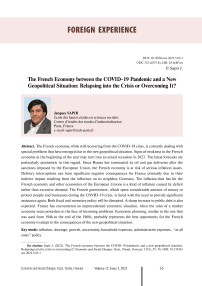The French economy between the COVID-19 pandemic and a new geopolitical situation: relapsing into the crisis or overcoming it?
Автор: Sapir Jacques
Журнал: Economic and Social Changes: Facts, Trends, Forecast @volnc-esc-en
Рубрика: Foreign experience
Статья в выпуске: 5 т.15, 2022 года.
Бесплатный доступ
The French economy, while still recovering from the COVID-19 crisis, is currently dealing with special problems that have emerged due to the new geopolitical situation. Signs of weakness in the French economy at the beginning of the year may turn into an actual recession in 2023. The latest forecasts are particularly pessimistic in this regard. Since Russia has terminated its oil and gas deliveries after the sanctions imposed by the European Union, the French economy is at risk of serious inflation issues. Delivery interruptions can have significant negative consequences for France primarily due to their indirect impact resulting from the influence on its neighbor, Germany. The inflation that has hit the French economy and other economies of the European Unions is a kind of inflation caused by deficit rather than excessive demand. The French government, which spent considerable amount of money to protect people and businesses during the COVID-19 crisis, is faced with the need to provide significant assistance again. Both fiscal and monetary policy will be disrupted. A sharp increase in public debt is also expected. France has encountered an unprecedented economic situation, when the rules of a market economy seem powerless in the face of incoming problems. Economic planning, similar to the one that was used from 1946 to the end of the 1960s, probably represents the best opportunity for the French economy to adapt to the consequences of the new geopolitical situation.
Inflation, shortage, growth, uncertainty, household expenses, administrative expenses,
Короткий адрес: https://sciup.org/147239123
IDR: 147239123 | DOI: 10.15838/esc.2022.5.83.3
Список литературы The French economy between the COVID-19 pandemic and a new geopolitical situation: relapsing into the crisis or overcoming it?
- Aglietta M. (1976). Régulation et Crises du Capitalisme. Paris: Camann-Levy.
- Aoki K. (2001). Optimal monetary policy responses to relative-price changes. Journal of Monetary Economics, 48(1), 55–80.
- Boyer R., Mistral J. (1983). Accumulation, Inflation et Crises. 2è ed. Paris: PUF.
- Dauvin M., Sampognaro R. (2021). Le modèle « mixte”: un outil ’évaluation du choc de la Covid-19”. Revue de l’OFCE, 2(172), 219–241.
- Greenwald B.C., Stiglitz J.E. (1989). Toward a theory of rigidities. American Economic Review, 79(2).
- Mankyw N.-G., Reis R. (2002). What Measure of Inflation Should a Central Bank Target. Working Paper. Harvard University.
- Mazier J., Baslé M., Vidal J.-F. (1984). Quand les Crises Durent. Paris: Economica.
- Sapir J. (2009a). La mise en concurrence financière des territoires. La finance mondiale et les États. In: Colle D. (Ed.). D’un protectionnisme l’autre – La fin de la mondialisation? Paris: Presses Universitaires de France.
- Sapir J. (2009b). The social roots of the financial crisis: Implications for Europe. In: Degryze C. (Ed.). Social Developments in the European Union: 2008. Bruxelles: ETUI.
- Sapir J. (2010). What should Russian monetary policy be? Post-Soviet Affairs, 26(4), 342–372.
- Sapir J. (2016). Global finance, national interests, and the model of development. In: Zapesotsky A.S. (Ed.). Contemporary Global Challenges and National Interest – The 16th International Likhachov Scientific Conference. Saint Petersburg.
- Sapir J. (2021). The economic shock of the health crisis in 2020: Comparing the scale of governments support. Studies on Russian Economic Development, 32(6), 579–592.
- Stiglitz J.E. (1989). Toward a general theory of wage and price rigidities and economic fluctuations. American Economic Review, 79.
- Streeck W. (2018). Du temps acheté. La crise sans cesse ajournée du capitalisme démocratique, Paris: Gallimard.
- Varoudakis A. (1995). Inflation, inégalités de répartition et croissance. Revue Economique, 46(3), 889–899.


